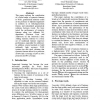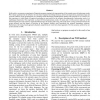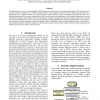25 search results - page 1 / 5 » Syntactic Features for High Precision Word Sense Disambiguat... |
COLING
2002
13 years 10 months ago
2002
This paper explores the contribution of a broad range of syntactic features to WSD: grammatical relations coded as the presence of adjuncts/arguments in isolation or as subcategor...
ACL
2003
14 years 8 days ago
2003
We present a supervised machine learning algorithm for metonymy resolution, which exploits the similarity between examples of conventional metonymy. We show that syntactic head-mo...
LREC
2010
14 years 10 days ago
2010
In this article, we present an experiment of linguistic parameter tuning in the representation of the semantic space of polysemous words. We evaluate quantitatively the influence ...
ACL
2001
14 years 8 days ago
2001
This paper describes automatic techniques for mapping 9611 entries in a database of English verbs to WordNet senses. The verbs were initially grouped into 491 classes based on syn...
LREC
2010
14 years 10 days ago
2010
This paper presents a word sense disambiguation (WSD) approach based on syntactic and logical representations. The objective here is to run a number of experiments to compare stan...



